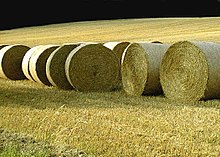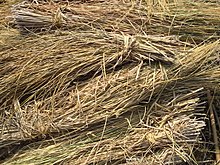Horticulture/Straw



Straw is an agricultural byproduct, the dry stalk of a cereal plant, after the nutrient grain or seed has been removed. Straw makes up about half of the yield of a cereal crop such as barley, oats, rice, rye or wheat. In times gone by, it was regarded as a useful by-product of the harvest, but with the advent of the combine harvester, straw has become almost a nuisance to farmers.
The most common use for straw is as bedding material for livestock, but it has a number of other uses as well. For the gardener, its most important use is as a mulch or as a bedding material to keep fruits such as strawberries or cucurbit crops off of the soil. Straw is a "cool" material (containing little nitrogen), and can be used fresh. Used straw from animal pens tends to be hot, and should not be used under food crops because of the risk of infectious organisms.
The biggest advantage of straw is that it is widely available and relatively inexpensive compared to other mulches. It also provides plentiful air and water circulation due to its texture, and can be laid thickly to discourage weeds. Its greatest liabilities are that it has a very low nutrient value, and its coarse texture and bright color is not universally appreciated by gardeners.
Other uses
[edit | edit source]Straw bales can be used for controlling runoff (as a silt screen), and are often used as building materials for raised beds, retaining walls, and compost piles. Straw bales can also be used for making mazes and other playground features for children (in fact it is even used in constructing houses), and in some parts of the world is used roofing, for making beds for people, and as packing material.
Straw is also used to cover the ground when lawns are seeded, creating some shelter for the seeds by regulating humidity, preventing seeds from being washed away by water or wind, and confusing hungry birds.
In Japan, certain trees are wrapped with straw to protect them from the effects of a hard winter as well as to use them as a trap for parasite insects.
Straw is used in ponds to reduce algae by changing the nutrient ratios in the water.

Still other uses include:
- There are several styles of straw hats that are made of woven straw.
- Archery targets, where heavy gauge straw rope is coiled and sewn tightly together. This is no longer done entirely by hand, but is partially mechanised.
- Corn dollies
- Straw marquetry
- Harvest crosses
- Basketry
- Bee skeps and linen baskets are made from coiled and bound together continuous lengths of straw. The technique is known as lip work.
- Rope made from straw was used by thatchers, in the packaging industry and even in iron foundries.
- Straw can be pulped to make paper.
- The use of straw as a carbon-neutral energy source for biofuels is increasing rapidly, especially for biobutanol.